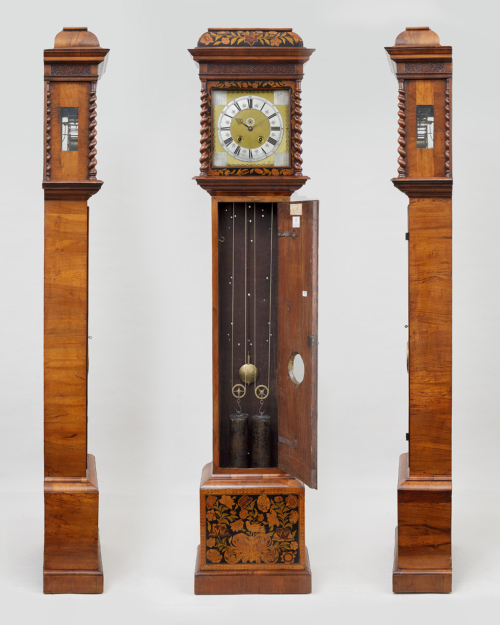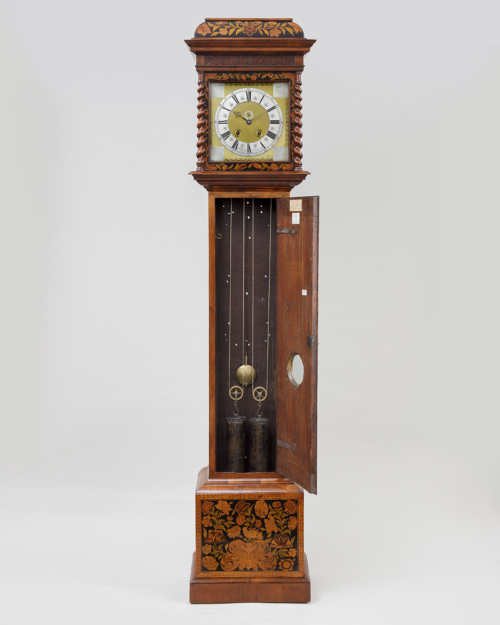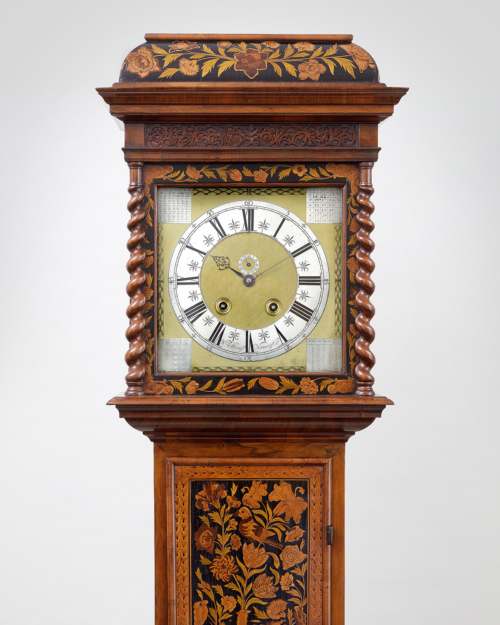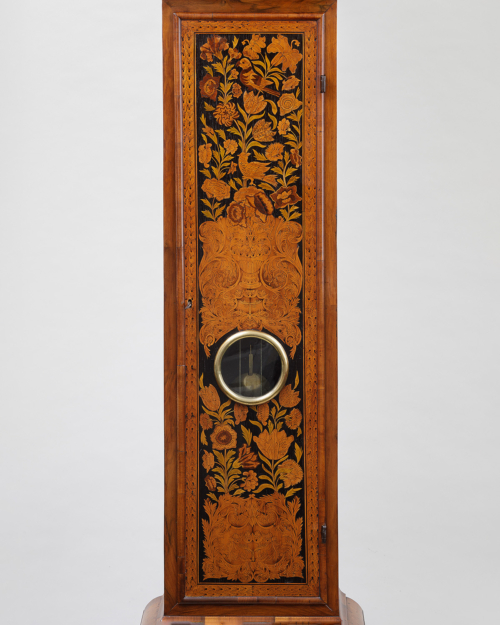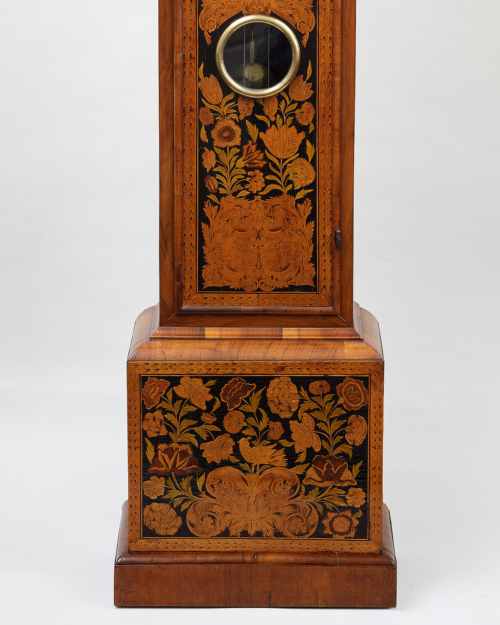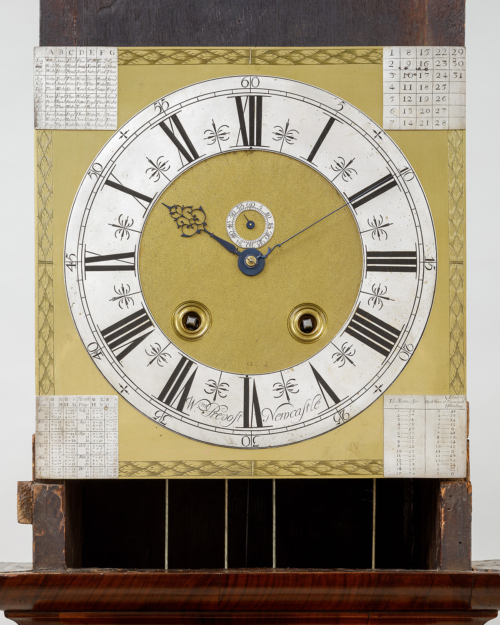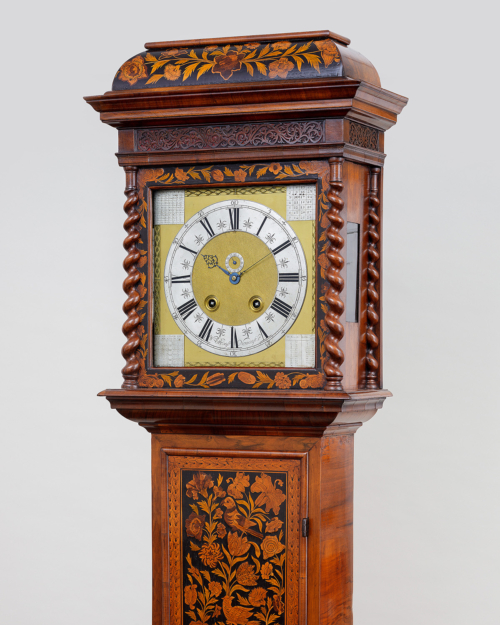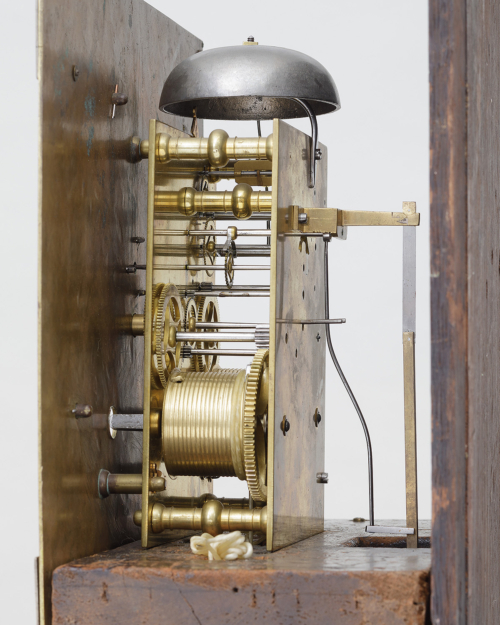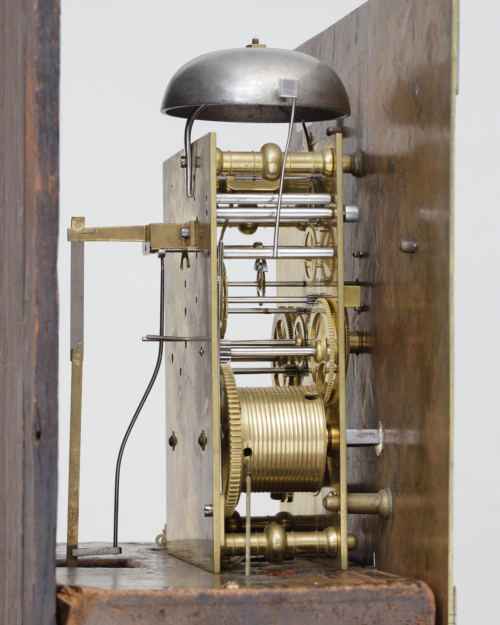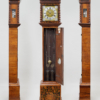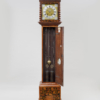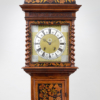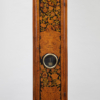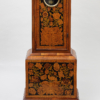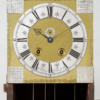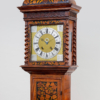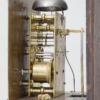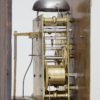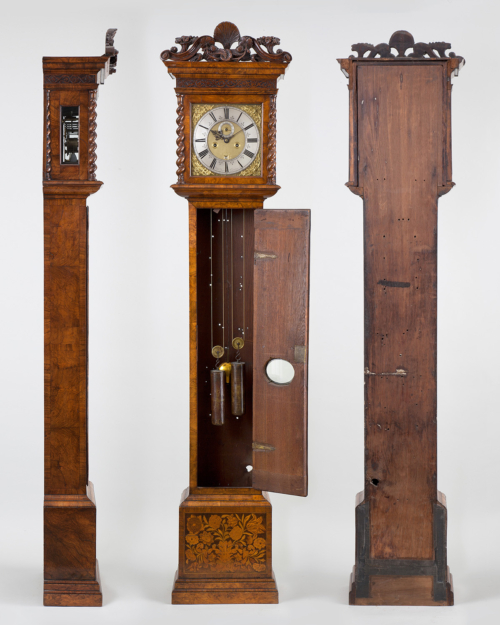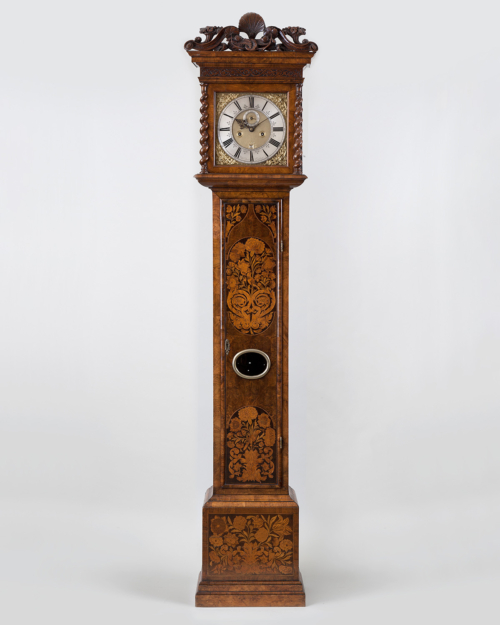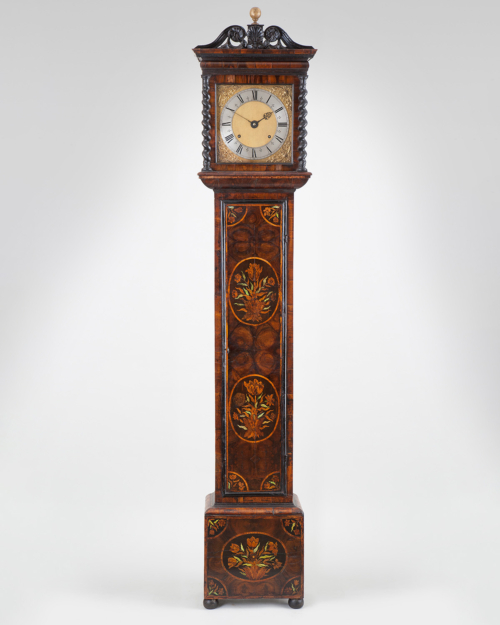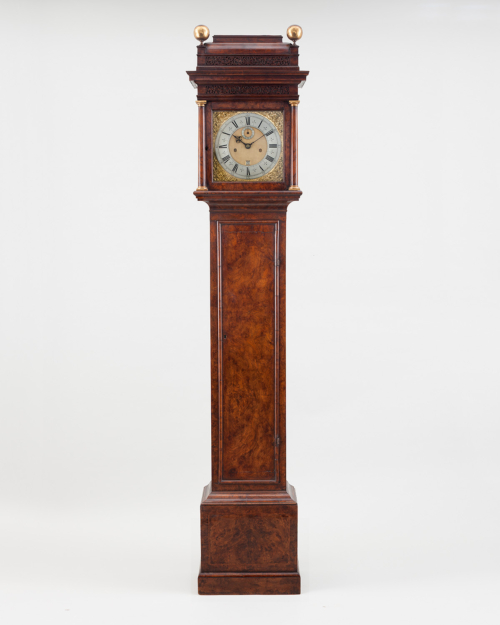| Height | 7 foot 4 inches (235 mm) |
| Case | The fine provincial case veneered in walnut, inlaid with floral marquetry, typically onto a pine carcass. The hood surmounted by a domed caddy top, with floral marquetry on an ebonised ground to the leading surface, over a walnut cornice and delicately fretted frieze, supported by slim reflective walnut Solomonic columns to the marquetry hood door, with matching side quarter-columns beyond the glazed side apertures. The trunk with walnut convex throat mouldings above the all-over marquetry trunk door with flowers, green-stained leaves, birds and scrollwork with a glazed, brass framed, pendulum lenticle, the sides veneered in plain walnut. The matching walnut base mouldings, over the similarly veneered base with flower and bird marquetry to the front, and a plain walnut skirt. |
| Dial | The 12 inch (305 mm) square brass dial with three latched dial feet, the fine matting with a low-planted small seconds ring above centre, and low positioned ring-turned winding holes. The silvered brass hour chapter, without quarter division ring but with arrowhead and cup half-hour marks between the Roman hours, and signed Wm Prevost, Newcastle flanking VI, the Arabic minutes with cross half-quarter marks between, are set outside the minute division ring, with light, delicately pierced and shaped, blued steel hands. The leaf-engraved border interrupted by four silvered plaques, providing an annual and monthly calendar, reference for moon phase and high tides. |
| Movement | The year going and striking movement with substantial plates and five latched finned baluster pillars, planted with high-count six wheel trains; the going with an anchor escapement and small diameter escape wheel and correspondingly small anchor pallets, with a long crutch moving between backplate mounted banking pins, the iron pendulum rod with delicate brass lenticular bob and knurled rating nut; the strike train is governed by a small inside countwheel striking on the large bell mounted above. |
| Duration | One year |
| Provenance | Anthony Woodburn July 1993 sold to Mr Francis Vitale, New Jersey, USA; |
| Literature | Richard Barder, English Country Grandfather Clocks, London, 1983, p.180-1, pl.115; |
| Escapement | Anchor with one second pendulum |
| Strike Type | Internal countwheel hour striking |
| Exhibited | 2003, Oxford & Liverpool, Horological Masterworks, exhibit no.44; 2004, Holland, Paleis Het Loo, Huygens’ Legacy, exhibit no.84. |
Exhibit № 35. William Prevost, Newcastle, Circa 1698
An exceptional provincial William III walnut and floral marquetry year-going and hour striking longcase clock
Sold
This is believed to be earliest known year-going and striking longcase clock made outside London, and it is believed to have been the result of a competition between William Prevost and another Newcastle clockmaker, the rather wonderfully named Deodatus Threlkeld (1657-1733). Tradition has it that, in 1698, the two makers had a contretemps in a Newcastle tavern as to which of them was the better clockmaker, a wager ensued and each agreed they would build a clock and return one year later. The two makers initially approached the Clockmakers’ Company to adjudicate, and their records show they declined to take any part in it, but two London clockmakers agreed to judge the bet in their stead: Samuel Watson and Edward Burgis.
On the appointed day, the ‘dueling’ clockmakers returned and the independent judges chose Threkeld’s clock, apparently deeming this example inferior. The victorious clock does not appear to have survived and details of it have also been lost, but to win over this year-going striking clock it must have been quite extraordinary. However, the story didn’t quite end there, although Threlkeld had been chosen as winner, it was later alleged that he had cheated with one of the judges accused of bias, owing to the fact that soon afterwards, William Threlkeld, either Deodatus’s son or nephew, had apparently become engaged to Samuel Watson’s daughter.
William Prevost was of French descent and born in circa 1662, but he was not a member of the Clockmakers’ Company. Loomes notes that in February 1690, he was described as a clockmaker of Newcastle, bachelor, aged 27, to marry Margaret Badudouin of Stepney spinster, 21, at St. Mary Magdelen, Old Fish Street. While Bates wrote in Clocks Magazine, December 1990 that By far the biggest threat to Threlkeld’s supremacy [in Newcastle] came… between 1685 and 1700, from one who appeared to be a London trained clockmaker, William Prevost, but little else appears to be recorded about him.
However, this extraordinary Newcastle provincial clock reflects much credit on William Prevost and the fully latched movement might be considered his masterwork, for it was no mean feat making a year-going clock, let alone one that also strikes the bell a minimum of 56,940 times during that duration. Few London makers were tackling long duration clocks at this time, but a small number of examples survive by Daniel Quare, and the majority are timepieces only.
The six-wheel going train has high numbered pinions to the two intermediate wheels, small centre, fifth and recoil escape wheel. The pallets are correspondingly small and have a very long crutch, which moves between banking pins on the back plate. The six-wheel striking train has similar intermediate wheels and an internal count wheel mounted on the fourth wheel arbor and normal, but very light striking work that allows it to operate for a full year. Perhaps in confirmation of this being Prevost’s own work, the arbors of both trains extend across the full separation of the plates, in place of the more usual sub-plates found in most long duration clocks. The case is typical of the finest provincial cabinet-work and has survived in remarkably good condition. The carcass is constructed in pine and, unsurprisingly, it is of a sturdy enough build to sustain the huge weights, while the marquetry itself is worthy of any London clock.
The dial is well finished and engraved, certainly up to London standards, while the silvered chapter ring seemingly affirms its provincial heritage, being without quarter-hour divisions that would only become common practice in London later in the 18th century. The blued steel hands are a very light design and extremely well finished.
There are four square silvered plaques in the dial corners in place of normal spandrel mounts which show annual calendrical information: in order to use the top left plaque, it is first necessary to deduce the Dominical or Sunday letter. To do this, add to the year its fourth part, add six, divide the total by seven and take the remainder. Select the Sunday letter, using the remainder, according to the following rules, for zero-A, 1-G, 2-F, 3-E, 4-D, 5-C and 6-B. In a Leap Year two letters are required, one deduced as above up to 29th February and the next succeeding letter for the remaining period of the year. The letter deduced would then be applied to the plaque and the day on which the 1st of January, and of the succeeding months, read and applied to the table at the top right plaque, the top line being Sunday, the next Monday etc. and the calendar for the month could then be drawn up.
The bottom left plaque is self-explanatory and gives the rising and setting of the sun but is of course based on the old Julian calendar, in which 10th March was the equinox; the times given are for London.
The bottom right plaque shows the times of high tide against the moon’s age and is apparently based on the tides at London Bridge and is thus up to about 1½ hours in advance of tides at Tinemouth (Tynemouth) and Whitebay (Whitby); bearing in mind the then-current state of tide theory this is not unreasonable.
Product Description
This is believed to be earliest known year-going and striking longcase clock made outside London, and it is believed to have been the result of a competition between William Prevost and another Newcastle clockmaker, the rather wonderfully named Deodatus Threlkeld (1657-1733). Tradition has it that, in 1698, the two makers had a contretemps in a Newcastle tavern as to which of them was the better clockmaker, a wager ensued and each agreed they would build a clock and return one year later. The two makers initially approached the Clockmakers’ Company to adjudicate, and their records show they declined to take any part in it, but two London clockmakers agreed to judge the bet in their stead: Samuel Watson and Edward Burgis.
On the appointed day, the ‘dueling’ clockmakers returned and the independent judges chose Threkeld’s clock, apparently deeming this example inferior. The victorious clock does not appear to have survived and details of it have also been lost, but to win over this year-going striking clock it must have been quite extraordinary. However, the story didn’t quite end there, although Threlkeld had been chosen as winner, it was later alleged that he had cheated with one of the judges accused of bias, owing to the fact that soon afterwards, William Threlkeld, either Deodatus’s son or nephew, had apparently become engaged to Samuel Watson’s daughter.
William Prevost was of French descent and born in circa 1662, but he was not a member of the Clockmakers’ Company. Loomes notes that in February 1690, he was described as a clockmaker of Newcastle, bachelor, aged 27, to marry Margaret Badudouin of Stepney spinster, 21, at St. Mary Magdelen, Old Fish Street. While Bates wrote in Clocks Magazine, December 1990 that By far the biggest threat to Threlkeld’s supremacy [in Newcastle] came… between 1685 and 1700, from one who appeared to be a London trained clockmaker, William Prevost, but little else appears to be recorded about him.
However, this extraordinary Newcastle provincial clock reflects much credit on William Prevost and the fully latched movement might be considered his masterwork, for it was no mean feat making a year-going clock, let alone one that also strikes the bell a minimum of 56,940 times during that duration. Few London makers were tackling long duration clocks at this time, but a small number of examples survive by Daniel Quare, and the majority are timepieces only.
The six-wheel going train has high numbered pinions to the two intermediate wheels, small centre, fifth and recoil escape wheel. The pallets are correspondingly small and have a very long crutch, which moves between banking pins on the back plate. The six-wheel striking train has similar intermediate wheels and an internal count wheel mounted on the fourth wheel arbor and normal, but very light striking work that allows it to operate for a full year. Perhaps in confirmation of this being Prevost’s own work, the arbors of both trains extend across the full separation of the plates, in place of the more usual sub-plates found in most long duration clocks. The case is typical of the finest provincial cabinet-work and has survived in remarkably good condition. The carcass is constructed in pine and, unsurprisingly, it is of a sturdy enough build to sustain the huge weights, while the marquetry itself is worthy of any London clock.
The dial is well finished and engraved, certainly up to London standards, while the silvered chapter ring seemingly affirms its provincial heritage, being without quarter-hour divisions that would only become common practice in London later in the 18th century. The blued steel hands are a very light design and extremely well finished.
There are four square silvered plaques in the dial corners in place of normal spandrel mounts which show annual calendrical information: in order to use the top left plaque, it is first necessary to deduce the Dominical or Sunday letter. To do this, add to the year its fourth part, add six, divide the total by seven and take the remainder. Select the Sunday letter, using the remainder, according to the following rules, for zero-A, 1-G, 2-F, 3-E, 4-D, 5-C and 6-B. In a Leap Year two letters are required, one deduced as above up to 29th February and the next succeeding letter for the remaining period of the year. The letter deduced would then be applied to the plaque and the day on which the 1st of January, and of the succeeding months, read and applied to the table at the top right plaque, the top line being Sunday, the next Monday etc. and the calendar for the month could then be drawn up.
The bottom left plaque is self-explanatory and gives the rising and setting of the sun but is of course based on the old Julian calendar, in which 10th March was the equinox; the times given are for London.
The bottom right plaque shows the times of high tide against the moon’s age and is apparently based on the tides at London Bridge and is thus up to about 1½ hours in advance of tides at Tinemouth (Tynemouth) and Whitebay (Whitby); bearing in mind the then-current state of tide theory this is not unreasonable.
Additional information
| Dimensions | 5827373 cm |
|---|

